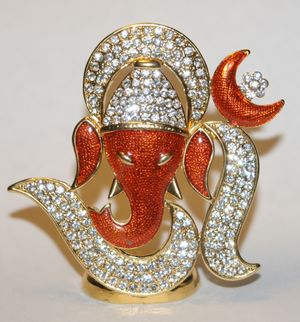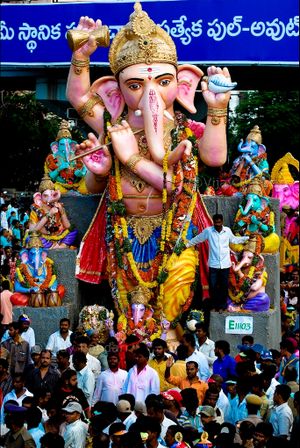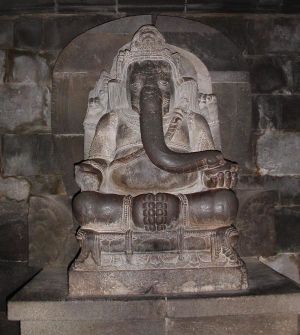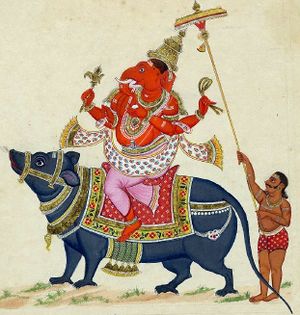گانـِشا
(تم التحويل من Ganesha)
خطأ لوا في وحدة:Effective_protection_level على السطر 63: attempt to index field 'TitleBlacklist' (a nil value).
| گانـِشا Ganesha | |
|---|---|
![Basohli miniature, حوالي 1730. المتحف الوطني، نيودلهي، الهند.[1]](/w/images/thumb/6/64/Ganesha_Basohli_miniature_circa_1730_Dubost_p73.jpg/275px-Ganesha_Basohli_miniature_circa_1730_Dubost_p73.jpg) | |
| دڤنگاري | गणेश |
| خط التاميل | கணேசா |
| الانتماء | دڤا |
| مانترا | ॐ गणेशाय नमः (Oṃ Gaṇeśāya Namaḥ) |
| السلاح | Paraśu (Axe),[2] Pāśa (Lasso),[3] Aṅkuśa (Hook)[4] |
| الرفيقة | Buddhi (الحكمة), Riddhi (prosperity), Siddhi (attainment) or sometimes, none |
| الجبل | Mouse |
گانـِشا Ganesha (بالسنسكريتية: गणेश; IAST: Gaṇeśa; listen )، وتنطق أيضا گانـِسا أو گانـِش، ويعرف أيضا باسم گاناپاتي (سنسكريتية: गणपति; IAST: gaṇapati), Vinayaka (سنسكريتي: विनायक; IAST: Vināyaka)، و Pillaiyar (بالتاميلية: பிள்ளையார்)، هو أحد الآلهة الشهيرة لدى الهندوس[5] توجد صورته في الهند ونيبال.[6].[7] ويقال أنها أكثر الآلهة عبادة في الهند.
التسمية وأسماء أخرى

Ganesha as 'Shri Mayureshwar' with consorts Buddhi and Siddhi, Morgaon (the central shrine for the regional aṣṭavināyaka complex)[8]
الأيقونات
السمات المشتركة
Vahanas

Ganesha dancing on his mouse, 11th century, Bengal, musée d'art asiatique de Berlin.
Associations
Obstacles

The Lalbaugcha Raja Ganesha image worshipped during Ganesh Festival in Mumbai, India. Ganesha is widely worshiped across India as the remover of obstacles.
Buddhi (Knowledge)
أوم

Ganesha (Devanagari) Aum jewel
First chakra
الأسرة والأقران
العبادة والأعياد
گانـِشا چاتورثي

Street festivities in Hyderabad, India during the festival of Ganesh Chaturthi
المعابد
تواجده
أول ظهور
تأثيراته
في الأدب

Vyasa narrating the Mahabharata to Ganesha, his scribe, Angkor Wat
Puranic period
الكتب المقدسة

Ganesha statue in 9th century Prambanan temple, Java, Indonesia
خارج الهند والهندوسية

5th century "image of Ganesha, consecrated by the Shahi King Khingala." found at Gardez, Afghanistan.
هوامش
- ^ "Ganesha getting ready to throw his lotus. Basohli miniature, circa 1730. National Museum, New Delhi. In the Mudgalapurāṇa (VII, 70), in order to kill the demon of egotism (Mamāsura) who had attacked him, Gaṇeśa Vighnarāja throws his lotus at him. Unable to bear the fragrance of the divine flower, the demon surrenders to Gaṇeśa." For quotation of description of the work, see: Martin-Dubost (1997), p. 73.
- ^
- For the paraśu (axe) as a weapon of Ganesha, see: Jansen, p. 40.
- For the paraśu as an attribute of Ganesha, see: Nagar, Appendix I.
- ^
- For the snare as a weapon of Ganesha, see: Jansen, p. 46.
- For the pāśa as weapon of Ganesha in various forms, see: Nagar, Appendix I.
- ^
- For the elephant hook as a weapon of Ganesha, see: Jansen. p. 46.
- For the aṅkuśa as an attribute of Ganesha, see: Nagar, Appendix I.
- ^ Rao, p. 1.
- ^
- Brown, p. 1. "Gaṇeśa is often said to be the most worshipped god in India."
- Getty, p. 1. "Gaṇeśa, Lord of the Gaṇas, although among the latest deities to be admitted to the Brahmanic pantheon, was, and still is, the most universally adored of all the Hindu gods, and his image is found in practically every part of India."
- ^
- Rao, p. 1.
- Martin-Dubost, pp. 2–4.
- Brown, p. 1.
- ^ Courtright, pp. 212–213.
- ^ Four-armed Gaṇeśa. Miniature of Nurpur school, circa 1810. Museum of Chandigarh. For this image see: Martin-Dubost (1997), p. 64, which describes it as follows: "On a terrace leaning against a thick white bolster, Gaṇeśa is seated on a bed of pink lotus petals arranged on a low seat to the back of which is fixed a parasol. The elephant-faced god, with his body entirely red, is dressed in a yellow dhoti and a yellow scarf fringed with blue. Two white mice decorated with a pretty golden necklace salute Gaṇeśa by joining their tiny feet together. Gaṇeśa counts on his rosary in his lower right hand; his two upper hands brandish an axe and an elephant goad; his fourth hand holds the broken left tusk."
- ^ This work and its description are shown in Pal, p. 125.
- ^ For a representation of this form identified as Maharakta, see Pal, p. 130.
المصادر
- Agrawala, Prithvi Kumar (1978), Goddess Vināyakī: The Female Gaṇeśa, Indian Civilization Series, Varanasi: Prithivi Prakashan
- Apte, Vaman Shivram (1965), The Practical Sanskrit Dictionary, Delhi: Motilal Banarsidass Publishers, ISBN 81-208-0567-4 (fourth revised and enlarged edition).
- Avalon, Arthur (1933), Śāradā Tilaka Tantram, Motilal Banarsidass Publishers, ISBN 81-208-1338-3 (1993 reprint edition).
- Bailey, Greg (1995), Ganeśapurāna: Introduction, translation, notes and index, Harrassowitz, ISBN 3-447-03647-8
- Bhattacharyya (Editor), Haridas (1956), The Cultural Heritage of India, Calcutta: The Ramakrishna Mission Institute of Culture Four volumes.
- Brown, Robert (1991), Ganesh: Studies of an Asian God, Albany: State University of New York, ISBN 0-7914-0657-1
- Chinmayananda, Swami (1987), Glory of Ganesha, Bombay: Central Chinmaya Mission Trust
- Courtright, Paul B. (1985), Gaṇeśa: Lord of Obstacles, Lord of Beginnings, New York: Oxford University Press, ISBN 0-19-505742-2
- Danielou, Alain (1954), The meaning of Ganapati, Madras: The Adyar Library bulletin
- Doniger, Wendy (1996), Merriam-Webster's Encyclopedia of World Religions, Merriam-Webster, ISBN 0-87779-044-2
- Ellawala, H (1969), Social History of Early Ceylon, Colombo: Department of Cultural Affairs.
- Flood, Gavin (1996), An Introduction to Hinduism, Cambridge: Cambridge University Press, ISBN 0-521-43878-0
- Getty, Alice (1936), Gaņeśa: A Monograph on the Elephant-Faced God (1992 reprint ed.), Oxford: Clarendon Press, ISBN 81-215-0377-X.
- Grimes, John A. (1995), Ganapati: Song of the Self, SUNY Series in Religious Studies, Albany: State University of New York Press, ISBN 0-7914-2440-5
- Gupta, Shakti M. (1988), Karttikeya: The Son of Shiva, Bombay: Somaiya Publications Pvt. Ltd., ISBN 81-7039-186-5
- Heras, H. (1972), The Problem of Ganapati, Delhi: Indological Book House
- Jansen, Eva Rudy (1993), The Book of Hindu Imagery, Havelte, Holland: Binkey Kok Publications BV, ISBN 90-74597-07-6
- Khokar, Ashish; S. Saraswati (2005), Ganesha-Karttikeya, New Delhi: Rupa and Co, ISBN 81-291-0776-7
- Krishan, Yuvraj (1981–1982), "The Origins of Gaṇeśa", Artibus Asiae (Artibus Asiae Publishers) 43 (4): 285–301, doi:
- Krishan, Yuvraj (1999), Gaņeśa: Unravelling An Enigma, Delhi: Motilal Banarsidass Publishers, ISBN 81-208-1413-4
- Krishna, Murthy, K. (1985), Mythical Animals in Indian Art, New Delhi: Abhinav Publications, ISBN 0-391-03287-9
- Macdonell, Arthur Anthony (1996), A Practical Sanskrit Dictionary, Munshiram Monoharlal Publishers, ISBN 81-215-0715-4
- Martin-Dubost, Paul (1997), Gaņeśa: The Enchanter of the Three Worlds, Mumbai: Project for Indian Cultural Studies, ISBN 81-900184-3-4
- Mate, M. S. (1988), Temples and Legends of Maharashtra, Bombay: Bharatiya Vidya Bhavan, http://books.google.ca/books?id=SY6GOwAACAAJ
- Metcalf, Thomas R.; Metcalf, Barbara Daly, A Concise History of India, ISBN 0-521-63027-4
- Nagar, Shanti Lal (1992), The Cult of Vinayaka, New Delhi: Intellectual Publishing House, ISBN 81-7076-043-9
- Oka, Krishnaji Govind (1913), The Nāmalingānuśāsana (Amarakosha) of Amarasimha: with the Commentary (Amarakoshodghāṭana) of Kshīrasvāmin, Poona: Law Printing Press, http://ia310939.us.archive.org/1/items/namalinganusasan00amariala/namalinganusasan00amariala.pdf, retrieved on 2007-09-14.
- Pal, Pratapaditya (1995), Ganesh: The Benevolent, Marg Publications, ISBN 81-85026-31-9
- Ramachandra Rao, S. K. (1992), The Compendium on Gaņeśa, Delhi: Sri Satguru Publications, ISBN 81-7030-828-3
- Saraswati, Swami Tattvavidananda (2004), Gaṇapati Upaniṣad, Delhi: D. K. Printworld Ltd., ISBN 81-246-0265-4
- Śāstri Khiste, Baṭukanātha (1991), Gaṇeśasahasranāmastotram: mūla evaṁ srībhāskararāyakṛta ‘khadyota’ vārtika sahita, Vārāṇasī: Prācya Prakāśana. Source text with a commentary by Bhāskararāya in Sanskrit.
- Śāstri, Hargovinda (1978), Amarkoṣa with Hindi commentary, Vārānasi: Chowkhambā Sanskrit Series Office
- Thapan, Anita Raina (1997), Understanding Gaņapati: Insights into the Dynamics of a Cult, New Delhi: Manohar Publishers, ISBN 81-7304-195-4
- Wilson, H. H. (1990), Rgveda-Samhita, Text in Devanagari, English translation Notes and indices by H. H. Wilson, Ed. W.F. Webster, New Delhi: Nag Publishers,11A/U.A. Jawaharnagar
وصلات خارجية
This article contains content from Wikimedia licensed under CC BY-SA 4.0. Please comply with the license terms.






